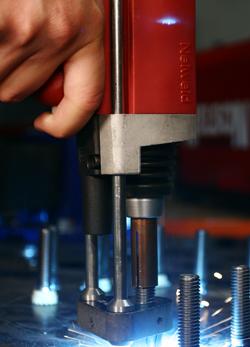Nowadays, it is hard to think of a world without stud welding. The invention of stud welding redefined the manufacturing industry, forever altering the automobile, shipbuilding, appliance, and construction industries. But where did this revolutionary fastening process come from?
The Origins of Stud Welding
Inventing the modern stud welder was a gradual process. The first stud welder was a simple device that would lift a stud by exciting a magnetic coil. Supposedly, the H. M. Dockyard in Portsmouth, England was the first business to actually utilize this machinery in 1918.

Arc Stud Welding Gun
Stud welding continued to improve, albeit modestly, as H. Martin and L. J. Steel worked toward created an automated stud welder. While they were successful in welding studs onto steel plates, but the machinery was too large and was far from automatic.
Like almost all inventions, stud welding was invented out of necessity. Mr. T. Nelson came up with electric arc stud welding just prior to World War II to fasten wood planks to naval aircraft carriers. Stud welding allowed for studs to be attached to the face of metal surfaces without having to drill through them, a very laborious and slow process.
Today, stud welding is used throughout the construction industry. Moreover, the versatility of stud welding has encouraged manufacturers to create a wealth of different studs, including deformed bars, rectangular, threaded studs, headed studs, pins, and more.
As a leading supplier of stud welding equipment and products, Sunbelt understands how crucial this machinery can be to your business. Let us work with you to help you find the right stud welding machine for your application and budget. Call 1-800-462-9353 or our Houston office at 713-939-8903 to learn more about our products and services.
